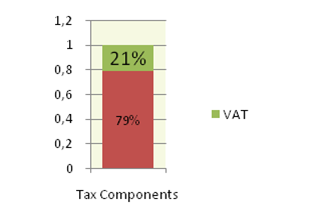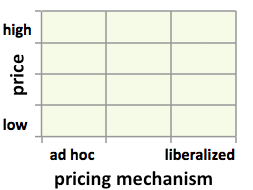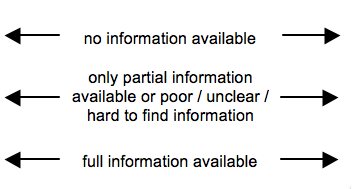Difference between revisions of "Fuel Prices Argentina"
***** (***** | *****) |
***** (***** | *****) m |
||
| (2 intermediate revisions by one other user not shown) | |||
| Line 1: | Line 1: | ||
{{Fuel Price Factsheet | {{Fuel Price Factsheet | ||
|Fuel Price Country=Argentina | |Fuel Price Country=Argentina | ||
| − | |Fuel Pricing Policies=Pricing policy: The sector was deregulated in 1989, but in recent years government has kept prices of all forms of energy low through domestic gas and electricity tariff freezes, indirect price controls on petroleum products, and heavy export taxes on oil. Government has been controlling prices in many sectors of the economy through “voluntary” price agreements since 2005 to curb inflation, including those with petroleum product retailers. In Jul 2012, an executive decree 1277/2012 was issued, abrogating sections of 1989 decrees that provided for the freedom to set prices and to import and export fuel. The decree established a new commission that has authority over pricing. Prices of LPG in 10-, 12-, and 15-kg cylinders sold to low-income households have been frozen for years. A federal fund for LPG provides stable LPG prices and helps expand natural gas pipeline networks. The diesel price for public transport used to be subsidized, costing government 6.5 billion pesos (US$1.5 billion) in 2011. Government brought the diesel price for public transport to be in line with the regular retail prices in early 2012. | + | |Fuel Pricing Policies="Pricing policy: The sector was deregulated in 1989, but in recent years government has kept prices of all forms of energy low through domestic gas and electricity tariff freezes, indirect price controls on petroleum products, and heavy export taxes on oil. Government has been controlling prices in many sectors of the economy through “voluntary” price agreements since 2005 to curb inflation, including those with petroleum product retailers. In Jul 2012, an executive decree 1277/2012 was issued, abrogating sections of 1989 decrees that provided for the freedom to set prices and to import and export fuel. The decree established a new commission that has authority over pricing. Prices of LPG in 10-, 12-, and 15-kg cylinders sold to low-income households have been frozen for years. A federal fund for LPG provides stable LPG prices and helps expand natural gas pipeline networks. The diesel price for public transport used to be subsidized, costing government 6.5 billion pesos (US$1.5 billion) in 2011. Government brought the diesel price for public transport to be in line with the regular retail prices in early 2012. |
Response to fuel tourism: Filling stations near the Brazilian border list two different prices for gasoline, one for cars with Argentinian license plates and another one for foreign plates, to restrict Brazilian drivers from buying cheaper fuel in Argentina. | Response to fuel tourism: Filling stations near the Brazilian border list two different prices for gasoline, one for cars with Argentinian license plates and another one for foreign plates, to restrict Brazilian drivers from buying cheaper fuel in Argentina. | ||
| Line 11: | Line 11: | ||
Information: There is comprehensive coverage on the Web of current and historical gasoline, kerosene, and diesel prices by location and company. Government uses price surveys to boost transparency and indirectly press companies to reduce prices. Monthly price surveys are carried out at filling stations and the National Statistics and Census Institute (Instituto Nacional de Estadistica y Censos, or INDEC) posts price and volume information for each filling station every month on its Web site, going back to Dec 2004." | Information: There is comprehensive coverage on the Web of current and historical gasoline, kerosene, and diesel prices by location and company. Government uses price surveys to boost transparency and indirectly press companies to reduce prices. Monthly price surveys are carried out at filling stations and the National Statistics and Census Institute (Instituto Nacional de Estadistica y Censos, or INDEC) posts price and volume information for each filling station every month on its Web site, going back to Dec 2004." | ||
| − | (Source: Kojima, Masami. (2013, forthcoming). “Petroleum product pricing and complementary policies:Experience of 65 developing countries since 2009.” Washington DC: World Bank.) | + | (Source: Kojima, Masami. (2013, forthcoming). “Petroleum product pricing and complementary policies:Experience of 65 developing countries since 2009.” Washington DC: World Bank.) |
|Fuel Currency=ARS | |Fuel Currency=ARS | ||
|Fuel Price Exchange Rate=3.9718 | |Fuel Price Exchange Rate=3.9718 | ||
| Line 48: | Line 48: | ||
|Fuel Price Factsheet Source Annotation=Argentinean Energy Institut (IAE) | |Fuel Price Factsheet Source Annotation=Argentinean Energy Institut (IAE) | ||
}} | }} | ||
| + | {{Fuel Price Factsheet Source | ||
| + | |Fuel Price Factsheet Source Type=Pump prices and margins | ||
| + | |Fuel Price Factsheet Source Link=http://res1104.se.gov.ar/consultaprecios.eess.php | ||
| + | |Fuel Price Factsheet Source Annotation=Prices for all provinces | ||
| + | }} | ||
| + | |||
| + | [[Category:Argentina]] | ||
Latest revision as of 10:02, 6 October 2014
Part of: GIZ International Fuel Price database
Also see: Argentina Energy Situation
Fuel Pricing Policies
| Local Currency: | ARS |
| Exchange Rate: | 3.9718
|
| Last Update: |
"Pricing policy: The sector was deregulated in 1989, but in recent years government has kept prices of all forms of energy low through domestic gas and electricity tariff freezes, indirect price controls on petroleum products, and heavy export taxes on oil. Government has been controlling prices in many sectors of the economy through “voluntary” price agreements since 2005 to curb inflation, including those with petroleum product retailers. In Jul 2012, an executive decree 1277/2012 was issued, abrogating sections of 1989 decrees that provided for the freedom to set prices and to import and export fuel. The decree established a new commission that has authority over pricing. Prices of LPG in 10-, 12-, and 15-kg cylinders sold to low-income households have been frozen for years. A federal fund for LPG provides stable LPG prices and helps expand natural gas pipeline networks. The diesel price for public transport used to be subsidized, costing government 6.5 billion pesos (US$1.5 billion) in 2011. Government brought the diesel price for public transport to be in line with the regular retail prices in early 2012.
Response to fuel tourism: Filling stations near the Brazilian border list two different prices for gasoline, one for cars with Argentinian license plates and another one for foreign plates, to restrict Brazilian drivers from buying cheaper fuel in Argentina. Pressure on oil companies to lower prices: In Aug 2010, government ordered oil companies to roll back price increases, while simultaneously threatening to apply the 1974 Law of Supply. Prices remained frozen between mid-Aug and mid-Dec. In February 2011, government issued a resolution after Shell Argentina raised gasoline and diesel prices by up to 3.6%, ordering Shell to reverse the price increases, imposing a price freeze, and requiring oil companies to maintain supplies to the local market at prior-year levels. The resolution was repealed in the following month. In Jan 2012, government accused oil companies of over-charging cargo transporters, launched an investigation, and later in the month ordered the companies to lower diesel prices for both cargo and passenger transport companies.
Consequences of subsidies: Some 3,500 retail outlets closed between 2005 and Mar 2010 because of poor profitability. Use of export tax to lower domestic prices: Until Jan 2013, the export tax on crude oil was 100% above US$45/barrel (bbl), making the export price US$42/bbl. Government relaxed the export tax in Jan 2013, raising the oil export price from US$42 to US$70/bbl.
Information: There is comprehensive coverage on the Web of current and historical gasoline, kerosene, and diesel prices by location and company. Government uses price surveys to boost transparency and indirectly press companies to reduce prices. Monthly price surveys are carried out at filling stations and the National Statistics and Census Institute (Instituto Nacional de Estadistica y Censos, or INDEC) posts price and volume information for each filling station every month on its Web site, going back to Dec 2004."
(Source: Kojima, Masami. (2013, forthcoming). “Petroleum product pricing and complementary policies:Experience of 65 developing countries since 2009.” Washington DC: World Bank.)
Fuel Prices and Trends
| Gasoline 95 Octane | Diesel | |
|---|---|---|
| in USD* |
|
|
| in Local Currency |
|
|
* benchmark lines: green=US price; grey=price in Spain; red=price of Crude Oil
Fuel Price Composition
Price composition for one litre of Gasoline 95 Octane as of 2002/12/01.


Source: http://uneprisoe.org/Pricing/FuelPricingPolicies.pdf pages 14 and 16
Pump prices based on IFP survey 2002.
Tax Components as of December 2010.
At a Glance
| Regulation-Price-Matrix |
| ||||
 |

|

|

| ||
Lack of information on fuel tax compositions
Sources to the Public
| Type of Information | Web-Link / Source |
|---|---|
| Other Information | http://uneprisoe.org/Pricing/FuelPricingPolicies.pdf |
| Other Information | http://www.baliloche.com.ar (Fundación Bariloche) |
| Other Information | http://www.iae.org.ar (Argentinean Energy Institut (IAE)) |
| Pump prices and margins | http://energia3.mecon.gov.ar/contenidos/verpagina.php?idpagina=3269 |
| Pump prices and margins | http://res1104.se.gov.ar/consultaprecios.eess.php (Prices for all provinces) |
Contact
Please find more information on GIZ International Fuel Price Database and http://www.giz.de/fuelprices




















